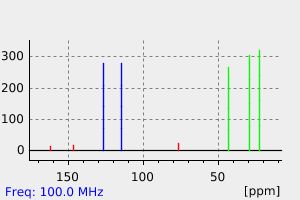1-(4-fluorophenyl)cycloheptan-1-ol | 77826-32-5
中文名称
——
中文别名
——
英文名称
1-(4-fluorophenyl)cycloheptan-1-ol
英文别名
1-(4-fluorophenyl)-cycloheptanol;1-(4-Fluorophenyl)cycloheptanol
CAS
77826-32-5
化学式
C13H17FO
mdl
——
分子量
208.276
InChiKey
UBKXZKJRGILRDW-UHFFFAOYSA-N
BEILSTEIN
——
EINECS
——
-
物化性质
-
计算性质
-
ADMET
-
安全信息
-
SDS
-
制备方法与用途
-
上下游信息
-
文献信息
-
表征谱图
-
同类化合物
-
相关功能分类
-
相关结构分类
计算性质
-
辛醇/水分配系数(LogP):3.3
-
重原子数:15
-
可旋转键数:1
-
环数:2.0
-
sp3杂化的碳原子比例:0.54
-
拓扑面积:20.2
-
氢给体数:1
-
氢受体数:2
上下游信息
-
下游产品
中文名称 英文名称 CAS号 化学式 分子量 —— 1-(4-fluorophenyl)cycloheptanamine —— C13H18FN 207.291
反应信息
-
作为反应物:描述:1-(4-fluorophenyl)cycloheptan-1-ol 在 N-溴代丁二酰亚胺(NBS) 、 (4,4'-di-tert-butyl-2,2'-dipyridyl)-bis-(2-phenylpyridine(-1H))-iridium(III) hexafluorophosphate 、 碘苯二乙酸 、 potassium iodide 作用下, 以 四氯化碳 、 水 、 甲苯 为溶剂, 反应 85.0h, 生成参考文献:名称:通过惰性C–C键断裂, 可见的光促进未应变环烷醇的开环官能化† •摘要:本文描述了新颖的,有用的,可见光促进的未应变环烷醇的开环官能化。断开惰性环状C-Cσ键后,一组中等大小和较大的环在温和的反应条件下很容易被溴化,得到相应的远端溴代烷基酮,否则很难合成。该产品是通用的构建基块,可通过一步操作轻松转换为其他有价值的分子。该方案也适用于未应变的环烷醇的空前的开环氰化和炔基化。DOI:10.1039/c8sc01763h
-
作为产物:参考文献:名称:由可见光光催化驱动的难以捉摸的热[2 + 2]环加成反应:利用应变进入C 2对称三环摘要:据报道,一种温和且操作简单的方法可用于合成嵌入C 2对称三环骨架中的环丁烷环。该方法使用可见光和铱基光催化剂来驱动环庚烯和类似物的常态“禁止”热[2 + 2]环加成反应。重要的是,它生成具有四个新的立体中心的环丁烷,这些立体中心具有出色的立体选择性和完美的区域选择性。当光催化剂吸收可见光光子时,该反应向前推进,可见光光子将这种能量转移到环庚烯上。成功的关键是,通过光催化剂的敏化作用激发三重态后,双键异构化,从而生成了瞬态的,高张力的反式-环庚烯。这反式-环庚经历应变缓和热,分子间[ π 2小号+ π 2一]与另一环的顺式-环庚。X射线分析表明,主要产物是头对头,C 2对称的全反式环丁烷。另外,通过使用具有一个立体中心的手性环庚烯醇,观察到的结构复杂性显着提高,这导致形成具有六个连续立体中心的环丁烷,具有良好或优异的非对映控制,可用于分离立体化学复杂的环丁烷的单一立体异构体。良品率高。DOI:10.1039/c8ob01273c
文献信息
-
Iodobenzene-catalyzed oxidative cleavage of olefins to carbonyl compounds作者:Lele Du、Zechao Wang、Junliang WuDOI:10.1016/j.tetlet.2020.152204日期:2020.8A metal-free approach for the oxidative cleavage of carbon–carbon double bonds of olefins to carbonyl compounds was established by using oxidant m-CPBA and non-metallic organocatalyst PhI in toluene/H2O. A broad scope of aromatic olefins was used. All the reactions proceeded smoothly at 35 °C in short reaction time to furnish the respective mono- and double carbonyl compounds selectively in moderate
-
Syntheses and N-methyl-D-aspartate Receptor Antagonist Pharmacology of Fluorinated Arylcycloheptylamines作者:Shengguo Sun、Jason Wallach、Adeboye AdejareDOI:10.2174/1573406410666140428104444日期:2014.10.23vivo efficacy. Syntheses and analyses of six novel compounds, 1-(4- fluorophenyl)cycloheptanamine (3), 1-(1-(4-fluorophenyl)cycloheptyl)piperidine (4), 1-(1-(4-fluorophenyl)cycloheptyl) pyrrolidine (5), 1-(3-fluorophenyl)cycloheptanamine (6), 1-(1-(3-fluorophenyl)cycloheptyl)piperidine (7), 1-(1-(3-fluorophenyl) cycloheptyl)pyrrolidine (8) and several related reference arylcyloalkylamines are described已知N-甲基-D-天冬氨酸受体(NMDAR)的苯环利定(PCP)结合位点的选择性非竞争性拮抗剂作为抗惊厥药和神经保护剂具有治疗潜力。设计了几个含环庚烷环的氟化分子,以探测PCP药效团并测试氟取代对NMDAR结合和体内功效的影响。六种新型化合物的合成与分析,即1-(4-氟苯基)环庚胺(3),1-(1-(4-氟苯基)环庚基)哌啶(4),1-(1-(4-氟苯基)环庚基)吡咯烷(5)1-(3-氟苯基)环庚胺(6),1-(1-(3-氟苯基)环庚基)哌啶(7),1-(1-(3-氟苯基)环庚基)吡咯烷(8)和描述了几种相关的参考芳基环烷基胺。3 H]-(+)-MK-801位移。出乎意料的是,与芳基环庚胺(如PCP)相比,3-氟伯胺6具有最大的亲和力,并且这些结合结果支持了芳基环庚胺的不同结构活性关系(SAR)谱。五个新化合物的亲和力(K i)在一百nM(10 -7)范围内。此外,对化合物3、5、6、7和
-
Electrophotochemical Ce-Catalyzed Ring-Opening Functionalization of Cycloalkanols under Redox-Neutral Conditions: Scope and Mechanism作者:Zhaoliang Yang、Dali Yang、Jianye Zhang、Chenyu Tan、Jiajun Li、Shengchun Wang、Heng Zhang、Zhiliang Huang、Aiwen LeiDOI:10.1021/jacs.2c05520日期:2022.8.3alcohols is gaining increasing interest in organic synthesis and biomass conversion. In particular, the development of redox-neutral catalytic methods with cheap catalysts and clean energy is of utmost interest. In this work, we report a versatile redox-neutral method for the ring-opening functionalization of cycloalkanols by electrophotochemical (EPC) cerium (Ce) catalysis. The EPC-Ce-enabled catalysis醇中 C-C 键的选择性裂解和功能化在有机合成和生物质转化中越来越受到关注。特别是开发具有廉价催化剂和清洁能源的氧化还原中性催化方法是最受关注的。在这项工作中,我们报告了一种通用的氧化还原中性方法,用于通过电光化学 (EPC) 铈 (Ce) 催化对环烷醇进行开环功能化。启用 EPC-Ce 的催化允许切割具有不同环尺寸的环烷醇,同时耐受广泛的官能团。值得注意的是,在氯化物作为抗衡阴离子和电解质存在的情况下,该方案选择性地导致形成 C-CN、C-C、C-S 或 C-肟键,而不是在 β-断裂后形成 C-卤化物键。初步机理研究表明,氧化还原活性 Ce 催化剂可以通过电氧化和光还原来调节,从而避免使用外部氧化剂。光谱表征(循环伏安法、UV-vis、电子顺磁共振和 X 射线吸收精细结构)表明了这种转化的 Ce(III)/Ce(IV) 催化途径,其中涉及 Ce(IV)-醇盐.
-
<i>N</i>-Haloimide-enabled halogenation <i>via</i> halogen-bond-assisted C–C activation of alkanols作者:Yan Geng、Yue Ma、Rui Huang、Xingwei Li、Songjie YuDOI:10.1039/d2gc03768h日期:——halogen-bond-assisted C–C activation of cyclic and acyclic alkanols in the absence of catalysts and oxidants, where the inexpensive N-haloimides act as bifunctional reagents to activate and halogenate alcohols. This redox-neutral protocol is a general method for the halogenation of the C–C bonds of primary, secondary, and tertiary alkanols, thus installing three types of halogen atoms and boronic esters
-
Auto de-bromine-coupling reactions of 1-aryl-7-bromocycloheptenes作者:Gon-Ann Lee、Hsin-Yi Lee、Wen-Chieh Wang、Chih-Hwa CherngDOI:10.1016/j.tet.2014.03.023日期:2014.5Auto de-bromine-coupling reactions of 1-aryl-7-bromocycloheptenes to a new series of [7-6-6] tricyclic system were described. A variety of substituents at the para-position of the phenyl were amenable to this transformation, including electron-donating groups and halides. The presence of electron-donating groups resulted in a more efficient reaction, with higher yields than the case of halides. (C) 2014 Elsevier Ltd. All rights reserved.
表征谱图
-
氢谱1HNMR
-
质谱MS
-
碳谱13CNMR
-
红外IR
-
拉曼Raman
-
峰位数据
-
峰位匹配
-
表征信息
同类化合物
(βS)-β-氨基-4-(4-羟基苯氧基)-3,5-二碘苯甲丙醇
(S,S)-邻甲苯基-DIPAMP
(S)-(-)-7'-〔4(S)-(苄基)恶唑-2-基]-7-二(3,5-二-叔丁基苯基)膦基-2,2',3,3'-四氢-1,1-螺二氢茚
(S)-盐酸沙丁胺醇
(S)-3-(叔丁基)-4-(2,6-二甲氧基苯基)-2,3-二氢苯并[d][1,3]氧磷杂环戊二烯
(S)-2,2'-双[双(3,5-三氟甲基苯基)膦基]-4,4',6,6'-四甲氧基联苯
(S)-1-[3,5-双(三氟甲基)苯基]-3-[1-(二甲基氨基)-3-甲基丁烷-2-基]硫脲
(R)富马酸托特罗定
(R)-(-)-盐酸尼古地平
(R)-(-)-4,12-双(二苯基膦基)[2.2]对环芳烷(1,5环辛二烯)铑(I)四氟硼酸盐
(R)-(+)-7-双(3,5-二叔丁基苯基)膦基7''-[((6-甲基吡啶-2-基甲基)氨基]-2,2'',3,3''-四氢-1,1''-螺双茚满
(R)-(+)-7-双(3,5-二叔丁基苯基)膦基7''-[(4-叔丁基吡啶-2-基甲基)氨基]-2,2'',3,3''-四氢-1,1''-螺双茚满
(R)-(+)-7-双(3,5-二叔丁基苯基)膦基7''-[(3-甲基吡啶-2-基甲基)氨基]-2,2'',3,3''-四氢-1,1''-螺双茚满
(R)-(+)-4,7-双(3,5-二-叔丁基苯基)膦基-7“-[(吡啶-2-基甲基)氨基]-2,2”,3,3'-四氢1,1'-螺二茚满
(R)-3-(叔丁基)-4-(2,6-二苯氧基苯基)-2,3-二氢苯并[d][1,3]氧杂磷杂环戊烯
(R)-2-[((二苯基膦基)甲基]吡咯烷
(R)-1-[3,5-双(三氟甲基)苯基]-3-[1-(二甲基氨基)-3-甲基丁烷-2-基]硫脲
(N-(4-甲氧基苯基)-N-甲基-3-(1-哌啶基)丙-2-烯酰胺)
(5-溴-2-羟基苯基)-4-氯苯甲酮
(5-溴-2-氯苯基)(4-羟基苯基)甲酮
(5-氧代-3-苯基-2,5-二氢-1,2,3,4-oxatriazol-3-鎓)
(4S,5R)-4-甲基-5-苯基-1,2,3-氧代噻唑烷-2,2-二氧化物-3-羧酸叔丁酯
(4S,4''S)-2,2''-亚环戊基双[4,5-二氢-4-(苯甲基)恶唑]
(4-溴苯基)-[2-氟-4-[6-[甲基(丙-2-烯基)氨基]己氧基]苯基]甲酮
(4-丁氧基苯甲基)三苯基溴化磷
(3aR,8aR)-(-)-4,4,8,8-四(3,5-二甲基苯基)四氢-2,2-二甲基-6-苯基-1,3-二氧戊环[4,5-e]二恶唑磷
(3aR,6aS)-5-氧代六氢环戊基[c]吡咯-2(1H)-羧酸酯
(2Z)-3-[[(4-氯苯基)氨基]-2-氰基丙烯酸乙酯
(2S,3S,5S)-5-(叔丁氧基甲酰氨基)-2-(N-5-噻唑基-甲氧羰基)氨基-1,6-二苯基-3-羟基己烷
(2S,2''S,3S,3''S)-3,3''-二叔丁基-4,4''-双(2,6-二甲氧基苯基)-2,2'',3,3''-四氢-2,2''-联苯并[d][1,3]氧杂磷杂戊环
(2S)-(-)-2-{[[[[3,5-双(氟代甲基)苯基]氨基]硫代甲基]氨基}-N-(二苯基甲基)-N,3,3-三甲基丁酰胺
(2S)-2-[[[[[((1S,2S)-2-氨基环己基]氨基]硫代甲基]氨基]-N-(二苯甲基)-N,3,3-三甲基丁酰胺
(2S)-2-[[[[[[((1R,2R)-2-氨基环己基]氨基]硫代甲基]氨基]-N-(二苯甲基)-N,3,3-三甲基丁酰胺
(2-硝基苯基)磷酸三酰胺
(2,6-二氯苯基)乙酰氯
(2,3-二甲氧基-5-甲基苯基)硼酸
(1S,2S,3S,5S)-5-叠氮基-3-(苯基甲氧基)-2-[(苯基甲氧基)甲基]环戊醇
(1S,2S,3R,5R)-2-(苄氧基)甲基-6-氧杂双环[3.1.0]己-3-醇
(1-(4-氟苯基)环丙基)甲胺盐酸盐
(1-(3-溴苯基)环丁基)甲胺盐酸盐
(1-(2-氯苯基)环丁基)甲胺盐酸盐
(1-(2-氟苯基)环丙基)甲胺盐酸盐
(1-(2,6-二氟苯基)环丙基)甲胺盐酸盐
(-)-去甲基西布曲明
龙蒿油
龙胆酸钠
龙胆酸叔丁酯
龙胆酸
龙胆紫-d6
龙胆紫







